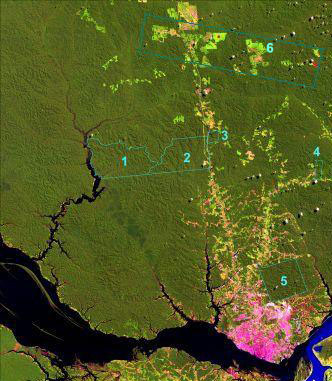Field infrastructure

A considerable part of INPA’s research is carried out at forest reserves and field stations under the direct tutorship of the Institute. The three main forest reserves (Ducke Reserve, Station of Experimental Silviculture and the reserves of the Biological Dynamics of Forest Fragments Project - BDFFP) are located at 25 to 90km north of Manaus, along the asphalted state highway to Itacoatiara (Ducke Reserve) and the federal highway BR-174 to Roraima and Venezuela (Silviculture Station and BDFFP). The three reserves have LTER (Long Term Ecological Research) status, constituting Site #1 (Manaus) of the Brazilian LTER.
Location of some of INPA’s reserves and field stations in relation to the city of Manaus (in pink). Manaus is located at the confluence of the blackwater Negro River (in black) and the whitewater Solimões River (in blue), to form the Amazon River.
In the 10,000-ha Ducke Reserve a 64-km2 trail grid was installed in 2001, with a 1x1-km resolution and 72 permanent sampling plots placed at regular 1-km intervals and conformed to terrain level curves. Four permanent roofed campsites are distributed throughout the grid to facilitate field logistics. The trail-grid at Ducke formed the first sampling site of the Research Program on Biodiversity - PPBio, a large-scale initiative for implementation of standardized sampling infrastructure in the Amazon basin (more about PPBio in the Institutional Projects tab). Many research projects by graduate students in Ecology at INPA since 2004 have been carried out in PPBio sampling infrastructure in the states of Amazonas, Roraima and Rondônia. Click here for an overview of all PPBio sampling sites in the Amazon.
The BDFFP reserves constitute a series of experimental forest fragments of different size categories set in a matrix of pastureland and secondary forests in the cattle farming district of Manaus, at 90km from the city along the BR-174 highway. The fragments were created in the 1980s and were re-isolated in the 2010s. The reserves are managed through a cooperation agreement between INPA and the Smithsonian Institution. The project runs a number of permanent roofed field camps with running water, electricity generator, kitchen facilities and radio communication with headquarters in Manaus. Transport, food and field hands are provided at a non-profit cost.
The LBA Project (Large-Scale Biosphere-Atmosphere Experiment) has three climate-observation towers and a permanent field station in the Station for Experimental Silviculture.
Project Amazon-FACE operates a field site at the Station for Experimental Silviculture consisting of forest plots exposed to experimental enhancement of atmospheric CO2 over a 10-year period.
Project ATTO (Amazon Tall Tower Observatory) installed a 300-m tower for atmospheric research in the Uatumã Sustainable Develpment Reserve, located on the margins of the Uatumã River, downstream from the Balbina dam lake. The site is managed through a cooperation project between INPA, the State University of Amazonas and the Max-Planck Institute for Chemistry (Germany).
INPA also operates four floating field stations (that adapt to the seasonal changes in water level of Amazonian rivers) in four marginal lakes of the Amazonas River in the region of Manaus (Tarumã, Marchantaria, Catalão e Lago Calado), and two medium to large-sized boats with laboratory facilities and lodging space for up to 40 persons.













